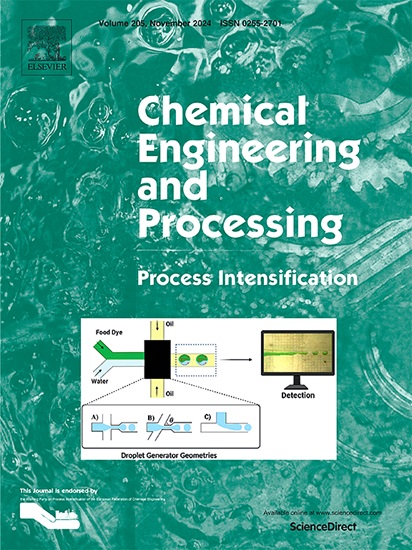Process optimization of microwave-assisted extraction (MAE) of polycyclic aromatic hydrocarbons (PAHs) from leaves of Murraya paniculata (L.) Jack: Process intensification approach
IF 3.8
3区 工程技术
Q3 ENERGY & FUELS
Chemical Engineering and Processing - Process Intensification
Pub Date : 2025-03-17
DOI:10.1016/j.cep.2025.110284
引用次数: 0
Abstract
Pervasiveness of polycyclic aromatic hydrocarbons (PAHs) in environment results in threatening health implications and ecological catastrophes. The study was aimed at developing a process intensified extraction route for isolation of PAHs from leaves of an established plant biomonitor, Murraya paniculata (L.) Jack. Microwave-assisted extraction (MAE) was targeted and its parameters were optimized through response surface methodology (RSM) incorporating Box-Behnken Design (BBD) in maximizing extraction yield of PAHs. Instrumental analysis of PAHs was validated based on desirable data of precision (RSD<1–2 %), accuracy (78–99 % recovery), LOD (0.001–0.003 µg g-1) and LOQ (0.03–0.09 µg g-1). Solvent selection through screening experiments followed by single factor analysis for solvent-to-sample ratio (V/W), extraction time and extraction temperature was carried out. In RSM, experimental and predicted response values showed a good fit for quadratic model and significance of the regression model was confirmed through analysis of variance (ANOVA) (F: 428.74; p < 0.0001). Extraction yield was maximized for extraction temperature: 45.77 °C, extraction time: 11.67 min and solvent-to-sample ratio: 22.64 mL g-1 with 98 % model accuracy. A comparison between Soxhlet and MAE highlighted the consumption of 1.8 fold higher volume of solvent, requiring 30 times more extraction time with high energy input in Soxhlet method, suggesting the intensified performance of MAE.

求助全文
约1分钟内获得全文
求助全文
来源期刊
CiteScore
7.80
自引率
9.30%
发文量
408
审稿时长
49 days
期刊介绍:
Chemical Engineering and Processing: Process Intensification is intended for practicing researchers in industry and academia, working in the field of Process Engineering and related to the subject of Process Intensification.Articles published in the Journal demonstrate how novel discoveries, developments and theories in the field of Process Engineering and in particular Process Intensification may be used for analysis and design of innovative equipment and processing methods with substantially improved sustainability, efficiency and environmental performance.

 求助内容:
求助内容: 应助结果提醒方式:
应助结果提醒方式:


